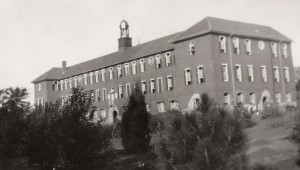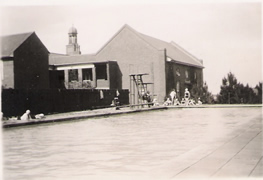Jeppe High School for Girls aims to serve as a centre of academic excellence for its community. It prioritises the empowerment and development of young women so that they may serve and lead in a multi-cultural South Africa.
Today there are three Jeppe schools in Johannesburg, each with its own buildings, grounds and playing fields. These three schools, have a common origin dating back to 1890.

The forerunner of the Jeppe Schools was St Michael’s College, founded as an Anglican private school on the corner of Commissioner and Crown Streets in Fairview. When the school opened in 1890 it had an enrolment of about twenty-five pupils. The Rector of St Mary the Less in Jeppestown, Rev H B Sidwell, was the first headmaster. He was succeeded in 1891 by the Rev George Perry.
In 1896 The Witwatersrand Council for Education purchased the college buildings and site as the school was struggling to exist. The council had been formed to enable the children of Uitlanders to receive the education not being provided for them by the state.
The Council re-opened the school as the Jeppestown Grammar School in April 1897. Mr J H Hardwick was appointed headmaster and 15 boys were enrolled. But financial problems soon after forced the council to cut down on expenditure and Mr Hardwick and his staff were given notice. A committee of Jeppestown parents eventually bought the school which changed hands on 1 October 1898 for £2 500.
Mr Hardwick stayed on as headmaster. The Parents‘ Committee was led by Mr E Hancock. Julius Jeppe, F Eckstein and Abe Bailey were patrons of the school. The outbreak of the Anglo-Boer War in 1899 caused the school to close down; the number of pupils dwindled steadily and Mr Hardwick himself had left by September 1899.


After the war the school re-opened as the Jeppestown High School for Boys and Girls in the same buildings as the Grammar School before the war. It was one of the six “Milner” schools opened by the Transvaal Education Department and was one of the first co-educational schools.
The exact date of the re-opening is unknown, but it was during the first quarter of 1902, for in a letter dated the 9 April, the Director of Education stated that the premises were inadequate for the number of pupils and that the teachers were refusing to work under these difficult and noisy conditions.
The building was still the property of the Parents’ Committee. They were experiencing financial difficulties at this time and by September, the Education Department had been presented with what amounted to an ultimatum to “purchase or vacate” the premises by October. On the advice of the Public Works Department the purchase was made until a new school could be built.
Mr C D Hope was appointed headmaster to the school in 1902 and remained there until the end of 1904. He was succeeded by Mr J H A Payne who had joined the staff in 1902 and who served the school as headmaster until his death on active service in 1918.
Mr Payne was responsible for obtaining premises and developing the school. The fine stone buildings in Kensington which are now occupied by the Boys’ School were started in 1909 and were designed by Ralston, a pupil of Sir Herbert Baker. In 1911 the boys and girls moved from their old premises in nearby Fairview to the new building in Kensington.
The School’s name had changed to Jeppe High School for Boys and Girls. Over the years the enrolment had increased steadily so that by 1912 even the new premises had become inadequate. The boys had always outnumbered the girls and after pressure from the Governing Body which was against co-education, it was decided that the girls should have their own school. Both Mr Payne and the then Director of Education were also protagonists of monastic schools.
Miss E L Cummins, who had joined the staff of the school in 1904, was to be the first headmistress of the new girls’ school. She and Mr Payne worked on the plans for the new buildings, but Mr Payne did not live to see building commence in 1918 nor the separation of boys and girls at the beginning of 1919.

In July 1919 the girls moved into their new red brick building comprising only the central wing of the present main building, having been housed in the Fairview Primary school for the first half of the year.
The Girls’ building had been planned during the economically stringent years of the First World War and construction had started in 1918, the last year of the war. Under Miss Cummins, the rocky, rubble-strewn terrain was transformed into acceptable grounds and the bare veld into playing fields. By the time Miss Cummins retired in 1930, the Hall and East and West wings had been added, with a library and laboratories, the gardens had been terraced and the trees in the upper and lower grounds planted. The swimming pool was opened in 1929.
It was intended at first that the Girls’ School should have boarders, indeed the sites of three hostels appear on early plans. These were to have been erected in the lower grounds facing the school, but were never built. A private hostel situated first in Somerset Road (1922-1933) and then in Roberts Avenue (1933-1946) served the school for some years.

A major addition to the Girls’ School as originally conceived came with the building in 1957 of the east block that provided laboratories and art and geography rooms. Extensive additions were made from 1984 to 1986 with the erection of the new block south of the main building. Here new laboratories and classrooms were provided. The province also undertook conversions in the main block to supply a larger library, six music rooms and space for an audio-visual room. As financial stringency prevented the authorities from providing all the facilities they had promised, the school, on its own account, at a cost of R180 000, added to the new block and converted part of the main block into suitable offices for the secretarial staff.
The Headmistresses who have succeeded Miss Cummins have all upheld the fine tradition and high standard that was set by her.
In May 1991, the parents of Jeppe High School for Girls voted to open the school up to all races, provided the admission criteria were met. This was implemented from the beginning of the third term in 1991 while Ms Thompson was Headmistress.
Mrs B Tobias became Headmistress of the school in 1997 and steered the school through the turbulent time of the implementation of the 2005 Curriculum and Outcomes Based Education system. She retired in November 2006, a highly respected member of the education fraternity.
Ms H Slabber was appointed as Headmistress in January 2007 and under her leadership, academics,sport and the cultural activities of the school continued to flourish. She played an instrumental role in attracting and developing sponsorship programmes for scholars. She left Jeppe at the end of 2010 to take up the post of Headmistress at Rhenish High in Stellenbosch.
Ms D Gonçalves was appointed Headmistress in April 2011. She had been an educator at the school since 1990 and deputy headmistress for the seven years prior to her appointment as Headmistress. She passed away on 9 June 2022 after a brave and private battle with cancer.
Mrs S Bhagwan was appointed Headmistress on 1 May 2023. She has been an educator at the school for the past 21 years and deputy headmistress for the past 11 years.
The school celebrated its centenary in 2019.
Headmistresses of Jeppe High School for Girls
1919 Ellen L Cummins B.A. (Hons) Oxford
1931 Mary McLarty M.A. (Durham)
1946 Sylvia G Sprigg MBE B.A. (Wits)
1949 E Alice Ramsbottom B.A.
1957 Ailsa M Reid B.Sc.
1974 Jean DE V Schutz B.A.
1991 Barbara JH Thompson B.A. (Hons)
1997 Beckie R Tobias B.A. T.T.H.D.
2007 Helmien Slabber B.A. Ed., M.Ed.
2011 Dina Gonçalves B.Sc.Hons, H.Dip.Ed.
2023 Sybil Bhagwan B.A.Hons, J.S. Ed.
